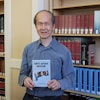University of California, Irvine hematologist Dr. Jae Chang specializes in blood cell analysis to diagnose obscure, complex disorders that stymie or get missed by many physicians. A writer of poetry and avid reader of mystery novels, his research across 30 years includes thrombotic thrombocytopenic purpura, or TTP, a rare disease that destroys red blood cells that normally deliver oxygen throughout the body. Among other things, TTP causes kidney or brain failure. The National Institutes of Health estimates TTP affects 1 in every 250,000 Americans.
DI: Tell us about one of your TTP patients.
JC: One man came to the UCI medical center with severe breathing problems. Other doctors determined he had acute respiratory distress syndrome, which is usually fatal if not corrected quickly, perhaps within two days. Its cause can be hard to pinpoint. When I studied this man’s blood cells, something in them reminded me of another case in which TTP had caused respiratory distress. So we administered plasma exchange, the standard therapy for TTP. After many weeks in the hospital, he left TTP-free. It’s a great joy helping critically ill patients. We cannot save them all because the clock works against us.
DI: Patients worldwide seek your help. Would you elaborate?
JC: I met a 29-year-old Honduran woman who came to the United States for treatment of sickle cell disease. She consulted me as a last resort. Back in Honduras, her anemia already had developed, and her chest pain was consistent with sickle cell. In California, another physician administered blood transfusions along with medication for chest and joint pain before I met her. The transfusions proved an overload of iron, so she was treated for that, too. Her prognosis and psyche were poor.
When I met her, she looked almost normal, whereas someone with advanced sickle cell often has osteoporosis and shortness of breath. Still, many diseases leave footprints in the blood. This woman didn’t have as many sickle cells in her blood as I expected. There was anemia in her blood count, and it appeared she inherited a gene abnormality from her mother that is typical of sickle cell. However, she didn’t have the second gene abnormality for sickle cell that I expected but instead evidence of hereditary persistence of fetal hemoglobin, which she likely got from her father.
Her blood disorder was actually much milder than originally feared, and she didn’t need so many transfusions going forward. If this patient manages her issues well, she might have a normal life expectancy. This summer, a woman with hemolytic anemia came from Korea to see me. She’d had the condition for more than 20 years. Within two days, I was pretty close to diagnosing the problem and hope to help her.
DI: You have published numerous journal articles about TTP. Why does it fascinate you?
JC: If diagnosed and treated in time, the patient can enjoy complete remission. I’ve been involved in more than 100 cases of TTP. Surgery can sometimes induce TTP, but many physicians mistake it in post-op as normal blood loss. So hematologists are important.
DI: You were already treating patients with leukemia and other blood cancers when your research branched into TTP and other rare disorders. Why take on so much?
JC: My vision problem ruled out becoming a surgeon. Becoming a blood specialist meant I would rely on a microscope. Blood is a wonderful universe, too. When you have a disadvantage like mine, try not to despair because the tables can be turned.















